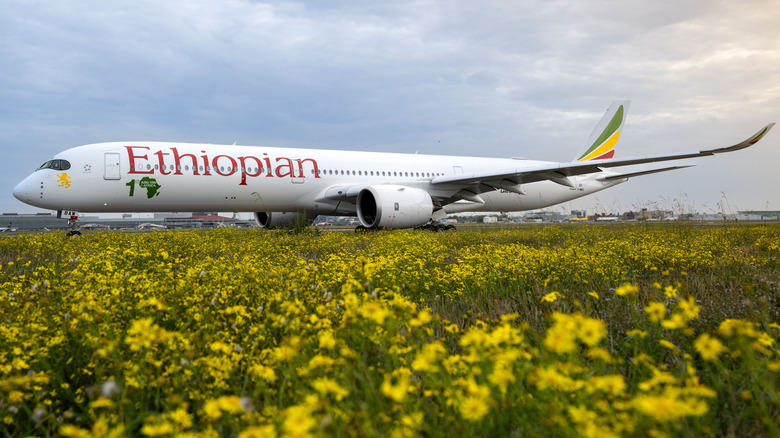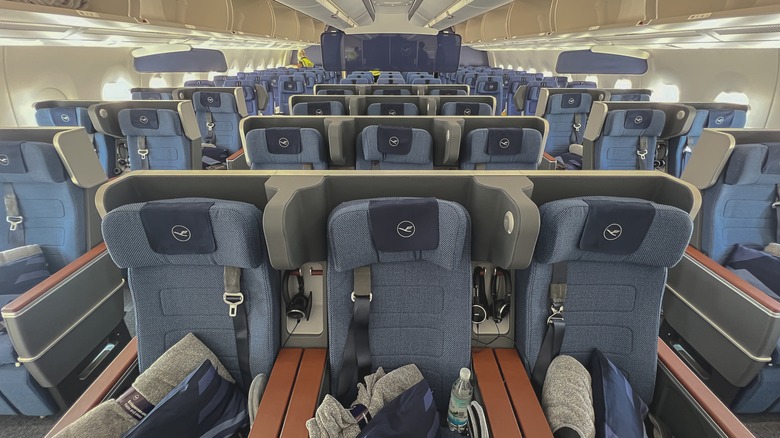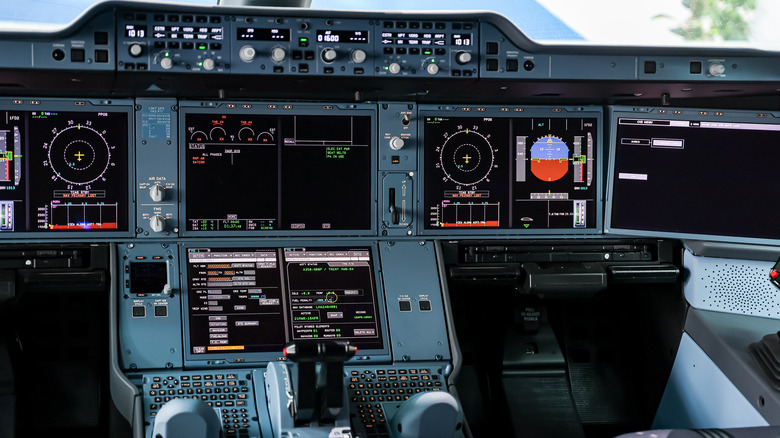Why The Airbus A350 Is Considered One Of The Best Jets For Long Flights
The Airbus A350 is one of the most modern airliners in today's skies. The wide-bodied A350 is a technologically advanced, long-haul airliner that directly competes with Boeing offerings like the 777 and the 787 Dreamliner. Indeed, it was Boeing's development of the Dreamliner that prompted Airbus to develop the A350. Initially, Airbus proposed that the plane would be a re-engined and re-winged version of its A330 airliner. However, a lack of market backing in the project saw Airbus taking the plunge and developing the A350 from scratch. This gave the company a blank canvas on which to let its engineers run loose. The result was a highly advanced aircraft that considerably improved passenger and crew comfort. Importantly, it also gave airliners an aircraft that was highly efficient, delivering 25% fuel savings when compared to older aircraft like the Boeing 777 range.
Ultimately, it was the decision to design the plane from scratch that enabled the advancements that place the Airbus A350 as one of the best airliners for long flights. This approach sidestepped the compromises that often have to be made when upgrading an existing model — Boeing's troubled 737 Max program is an extreme example of how badly this can go wrong. As a result, Airbus created an aircraft from scratch that not only delivered increased passenger comfort but also delivered significant advantages for the crew and airlines. Let's take a closer look at these advantages and the engineering that achieved them.
Airbus A350 - Long-haul flight advantages for passengers
All the innovations incorporated into a plane's design will count for practically nothing if passengers are left bleary-eyed, sore, and bedraggled after a long flight. However, the Airbus A350 can't be accused of this. The aircraft has been engineered to ensure that passengers remain as comfortable as possible throughout the entire flight. There are several metrics to consider that show how passenger comfort has been integrated into the design. First, let's look at the cabin pressure. The Airbus A350 fuselage is built from 70% advanced lightweight materials, including carbon fiber. This allows the pressure within the cabin to be kept at a 6,000 ft equivalent (most airliners have a pressure equal to that at 8,000 ft), which, when paired with the aircraft's improved humidity levels, can lead to less passenger fatigue.
The use of advanced materials also allowed Airbus to design a non-circular fuselage, which means more headroom and a wider cabin for greater passenger comfort. Lighting is also important for comfort, and the A350 uses LED mood lighting to this end. Additionally, the cabin is also remarkably quiet. The Rolls-Royce Trent XWB engines that power the plane are designed to reduce noise pollution. The fuselage also features advanced acoustic insulation to further improve cabin noise levels. Other innovations improving passenger comfort include electro-dimmable windows and an in-flight entertainment system. Finally, the Airbus A350 is also one of the fastest airliners flying today. The latter is important, as no matter how comfortable a cabin is, passengers still want to arrive as quickly as possible.
Airbus A350 - Crew and airline benefits
For airlines, the bottom line is obviously a major factor. The 25% lower operating costs of the Airbus A350 — when compared to some other wide-bodied jets — is therefore a big carrot. These savings can be attributed to the advanced materials that allowed the weight of the aircraft to be minimized. Also, one of the most expensive jet engines ever — the Rolls-Royce Trent XWB — is among the most efficient in its class. Another factor that airlines love is the range of the jet. As an example, the Airbus A350-900ULR flown by Singapore Airlines has the longest range of any commercial jet at 9,700 nautical miles (11,163 miles).
The flight crew also benefits from the plane's engineering. The cockpit has been designed with the comfort of the flight crew in mind. Comfortable seats, an intuitive cockpit layout, and an advanced head-up display system, all help to keep the flight crew comfortable during long flights. The advanced avionics are also designed to reduce flight crew workload while maintaining situational awareness. Additionally, improved safety systems and commonality of systems across the Airbus range are also appreciated by pilots.
Finally, we can look at this from a cabin crew perspective. They also benefit from the reduced cabin pressure and the quieter working atmosphere. But the plane also features larger work areas, galleys, and crew rest areas. In short, for long-haul flights, the Airbus A350 is a plane that is comfortable for passengers and crew, and convenient and economical for airlines.


